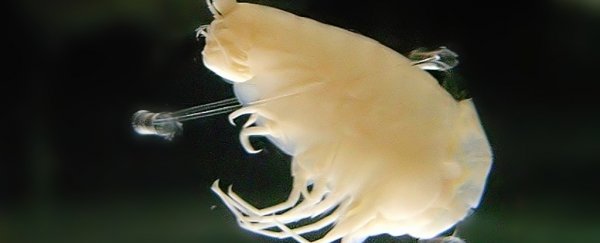Life isn't easy at the bottom of Challenger Deep – at nearly 11,000 metres (36,000 feet) the deepest point of the oceans – and scientists just shed some light on how tiny creatures are able to survive at these phenomenal depths.
It turns out that the Hirondellea gigas amphipods (small crustaceans) manufacture themselves tiny suits of aluminum armour to resist the crushing pressures and freezing temperatures on the sea floor.
And these shrimp-like creatures are rather clever about it too, sucking up the metal-rich sediment at the bottom of the ocean and mixing it with gut chemicals to create a protective aluminum hydroxide gel.
That reaction between the plant life that H. gigas usually snacks on and the aluminum in the ocean sediment frees up aluminum ions. There's then a second chemical reaction as these ions are released back into the water.
"The extracted aluminum ions are transformed into the gel state of aluminum hydroxide in alkaline seawater, and this gel covers the body to protect the amphipod," write the researchers from the Japan Agency for Marine-Earth Science and Technology and the Bio-nano Electronics Research Centre, Toyo University.
"This aluminum gel is a good material for adaptation to such high-pressure environments."
Ordinarily, amphipods can't go any lower than 4,500 metres (14,764 feet) without breaking up under the pressure – but the Challenger Deep part of the Mariana Trench is more than double that.
Sink down to those depths and the pressure is about a thousand times greater than you'd feel walking around on land. It's been described as having the point of the Eiffel Tower on top of your big toe.
To investigate the mystery of how H. gigas survives, the researchers collected a bunch of the amphipods from Challenger Deep as well as the Izu-Ogasawara Trench. They then added sediment from Challenger Deep and analysed the reactions.
According to the study team, the self-made aluminum gel shell that H. gigas produces could ward off predators as well as help the creatures cope with the intense pressure – it appears to trap in calcium carbonate, stopping the exoskeleton from disintegrating.
Perhaps it's a technique that could help in the development of the deep sea submersibles of the future. Filmmaker James Cameron is one of only three people to have ever made the descent right to the bottom of Challenger Deep.
The study also gives us a little more insight into how underwater ecosystems work at great depths in both high pressure and very cold temperatures.
All sorts of strange and wonderful organisms exist down in the deep, and we're only just discovering what lets them live and thrive in some of the most hostile environments on Earth.
At least when it comes to the H. gigas amphipods, we now know more about their crazily smart survival techniques.
"Aluminum gel and organic components would act as a shield against high pressure and keep calcite in the exoskeleton to enable H. gigas to survive on the deepest sea floor," conclude the researchers.
The research has been published in PLOS One.
